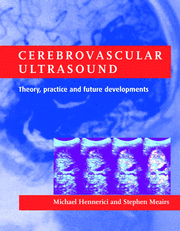Preface
Published online by Cambridge University Press: 05 July 2014
Summary
Ultrasound, an imaging technique that is safe, reliable, and relatively inexpensive, has played an increasingly important role in evaluation of cerebrovascular diseases over the last decade. This modality provides morphological and functional information on arterial walls at sites prone to atherosclerosis and allows surveillance of quantitative measurements of disease progress. Ultrasound has assumed a key position in recent epidemiological studies and is being used increasingly for assessment of the efficacy of atherosclerosis prevention trials. New developments in ultrasound equipment and novel methods for three- and four-dimensional sonography have broadened the scope of imaging arterial walls, providing both enhanced information on disease progression as well as new insights into pathomechanisms of plaque embolization. The role of transcranial Doppler microembolism detection has been expanded and improved methods for distinguishing between artefact and microembolism have been introduced. Recent highlights in cerebrovascular ultrasound research include imaging methods for characterization of intracranial aneurysms, use of echocontrast agents for improved evaluation of acute stroke patients and harmonic imaging for depiction of brain perfusion. New functional transcranial Doppler applications that are complementary to position emission tomography and functional magnetic resonance imaging studies are evolving for evaluation of functional recovery after stroke, investigation of perfusion asymmetries during complex spatial tasks, and elucidation of temporal patterns of regional neuronal activity. Exciting new developments are under way to introduce low-frequency ultrasound as a therapeutic adjunct in acute thrombolysis, thus greatly expanding the role of cerebrovascular ultrasound in stroke care.
- Type
- Chapter
- Information
- Cerebrovascular UltrasoundTheory, Practice and Future Developments, pp. xiii - xivPublisher: Cambridge University PressPrint publication year: 2001



